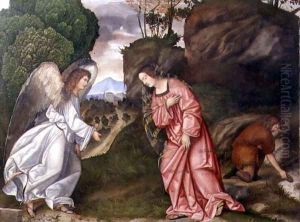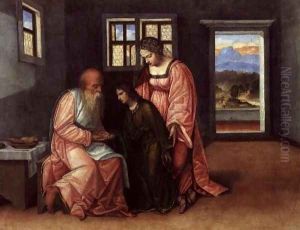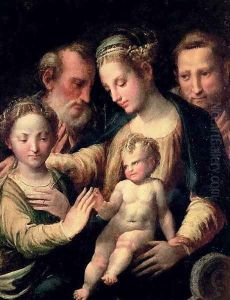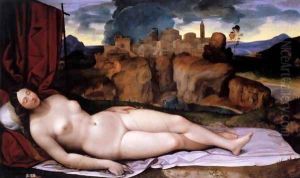da Treviso II (Girolamo Pennacchi) Girolamo Paintings
Girolamo Pennacchi, better known as Girolamo da Treviso II to distinguish him from an earlier artist of the same name, was an Italian painter and draftsman of the Renaissance period. Born in 1490 in Treviso, a town in the Veneto region of Italy, he was a versatile artist whose work included religious compositions, portraits, and frescoes.
Pennacchi's early life and training are not well-documented, but it is believed that he may have been a pupil of Pordenone, an Italian painter of the Venetian school, which could explain the influence of Venetian colorism and the dynamic composition style seen in Pennacchi's work. He was also influenced by the works of Raphael and Michelangelo, evident in his sophisticated use of perspective and anatomy.
Around the 1520s, Girolamo moved to Bologna, where he worked on various projects, including the decoration of the Palazzo del Podestà. His style during this period was characterized by a strong sense of design and a keen eye for detail.
In the 1530s, he moved to England, where he entered the service of Henry VIII, becoming part of the circle of artists brought to the English court by the king to enhance the grandeur of his reign. During his time in England, Pennacchi worked on several projects, including designs for tapestries and possibly even participated in the decoration of the Palace of Whitehall under the supervision of Hans Holbein the Younger.
Girolamo da Treviso II's career in England was cut short when he was killed during the Siege of Boulogne in 1544, during the Italian War of 1542–1546. He was reportedly struck by cannon fire, an unusual end for an artist of his time. His death deprived the Italian Renaissance of a prolific and innovative talent who had begun to successfully bridge the traditions of Italian painting with the burgeoning art scene of Tudor England.
Most of Girolamo da Treviso II's works have been lost or are unattributed, but some surviving examples reflect the transition from the High Renaissance to the Mannerist style. His paintings are noted for their expressive figures and dramatic use of light and shadow, contributing to the rich tapestry of 16th-century Italian art.



